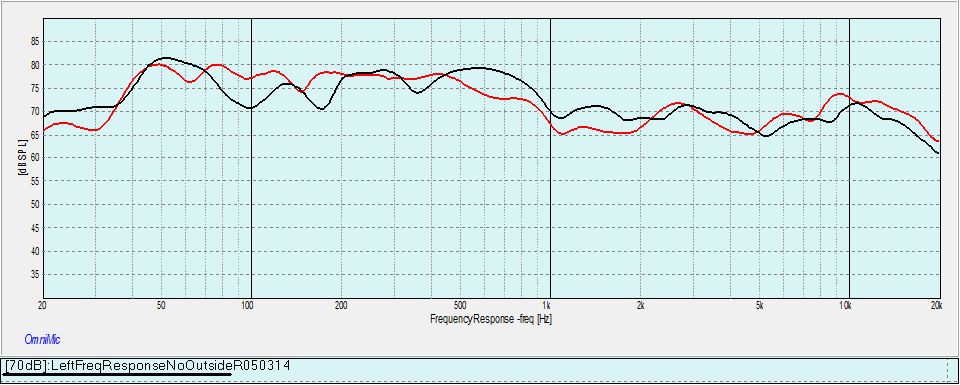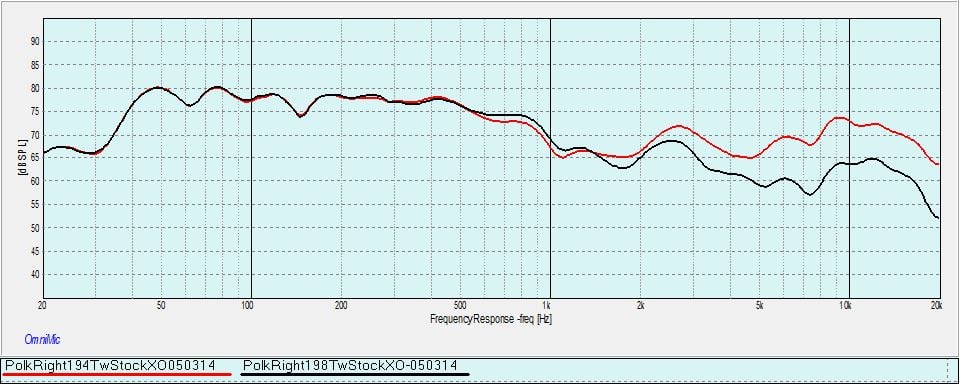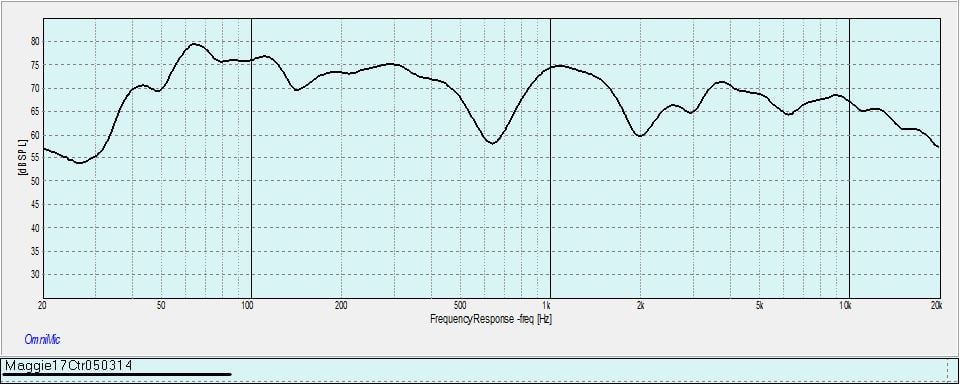Response plots from 2.3s, and Maggie 1.7s
SciFiTom
Posts: 58
Well, I guess I got a new toy, and thought I'd share a bit. All plots were taken sequentially, from my listening position. Mic pointing forward toward the speakers at a distance of about 15 Ft. Obviously, this isn't altogether scientific, as room effects are significant.
The black plot is my LH speaker, modded with RDO-198s, new caps, new resistors, new tweeter inductors, something like the TL TWEETER schematic (only), and the iron core interconnect inductor touted by Westmassguy, as I recall. (Relax, I'm not done yet).

The red plot is the right side, rock stock XO (many years old) with RDO-194s. I can certainly understand those who strongly suggested I just do that (as I've said before). It would seem that refreshing the XO parts on the right would probably be pretty nice.
In this one, the red curve is the RDO-194s, the black is RDO-198s without any other changes to the rock stock box. As has been stated by others, the impedance of the 198s is lower, so you'd expect a lower output without other changes.

And, just for grins, here's a plot of my Magnepan 1.7s playing center channel. I thought I'd include this, partly because I saw a post where one gent was wanting to move over to the Maggie side. This may change his opinion.

Let's see whether the magic works,
Tom
The black plot is my LH speaker, modded with RDO-198s, new caps, new resistors, new tweeter inductors, something like the TL TWEETER schematic (only), and the iron core interconnect inductor touted by Westmassguy, as I recall. (Relax, I'm not done yet).

The red plot is the right side, rock stock XO (many years old) with RDO-194s. I can certainly understand those who strongly suggested I just do that (as I've said before). It would seem that refreshing the XO parts on the right would probably be pretty nice.
In this one, the red curve is the RDO-194s, the black is RDO-198s without any other changes to the rock stock box. As has been stated by others, the impedance of the 198s is lower, so you'd expect a lower output without other changes.

And, just for grins, here's a plot of my Magnepan 1.7s playing center channel. I thought I'd include this, partly because I saw a post where one gent was wanting to move over to the Maggie side. This may change his opinion.

Let's see whether the magic works,
Tom
Post edited by SciFiTom on
Comments
-
Very interesting is all I'm going to say so I don't start a big fight. :eek: I would love to see an SL-2000 tested against the 194. Do you have one?'65 427 Shelby Cobra
'72 Triumph TR-6
__________________
'88 Polk SDA SRS 1.2, with upgraded XO caps and Erse SDA inductors
'86 Polk SDA CRS+
'84 Polk Monitor 10A (Peerless tweeters)
'05 HSU VTF-3 Sub (Original OEM)
'20 HSU VTF-3 Sub (three more, 100% cloned)
'93 Carver TFM-35
'88 Carver M-1.0t
'88 Adcom GFT-555
'88 Adcom GFP-555
'88 Adcom GFA-555 (upgraded/restored)
'88 Adcom GFA-555 (a second one upgraded/restored)
'05 Onkyo DV-555 media
'89 Fosgate 360 Digital Space Matrix
'89 Fosgate 360 Digital Space Matrix, internal surround amp bridged to drive only a center channel
'91 Kenwood Basic M1D Amp
'89 Pioneer Laser Disc media
'89 Sony SuperBeta HiFi media
One PGA2310 based custom built remote volume control
Four Polk T-15's
Four Polk TSi-200's
Four Polk TSi-100's
Two Polk CS-10's -
OldmanSRS,
I'm pursuing the 198s because, of the 3 tweeters I've tried from Polk, my daughter and I like them best (her input is considered for the ears of a young person). They (or my present XO) provide a more open, airy feel - where even the 194s are still tied more closely to the box. Since I came to the Polks from Magnepan, it's hard to live without the clean, fast, and open response they offer.
I do still have the SL-2000s, and it isn't that hard to swap them out. I don't promise immediate action, but I, too, am curious about the SL-2000s vs. the RDO-194s. It seems to me that there's still a bit of a hump at around 12kHz with the 194's that I'd like a comparison for.
I have a Diana Krall recording where the sibilants are nearly unbearable - that's why I added some R in front of the other speaker, but it seems to have a very negative effect on the flatness of the response (not too surprising, in EMC work there's something called the "waterbed effect" - push it down over here, it pops up elsewhere).
I bought the OmniMic because I can't trust my own ears anymore, and feared my XO "design" was pushing the curve up on the top end, perhaps that was causing the openness (and the sibilant harshness). Apparently not.
I'm not particularly satisfied with the results I show here, so I will be working on these speakers more. This wasn't intended as a gloating exercise, I'm just showing some values I got in hopes others may benefit, or provide me insight on the "true path." Since I'm not at all sure that the results are really accurate, I'm presenting them in the form of relative comparisons.
If you have something to say, I'd be pleased to read it. Other posts I've seen from you do not seem to be bad-spirited, and my skin isn't all THAT thin. I will consider your opinions if you offer them. Doesn't mean I'll go that way, though.
Tom -
I am assuming you correctly modified the polk 2.3's crossover to use the rdo198? rdo194 is what most of us use to replace the sl2000 on this model speaker.There is no cure....
Luxman M117, SDA SRS 2.3, rear monitor 10, back rear bose 4.2, valodyne sub and 2 Onkyo m-504 amps Onkyo TX-NR709
8mm, 7.62x39mm -
....As has been stated by others, the impedance of the 198s is lower, so you'd expect a lower output without other changes.
Don't know who would have said that or what backwards thinking they were using. In most cases you are doing to get double the output as there is half the impedance. The resulting lower impedance would cut the crossover point in half and could be dangerous for the tweeter. I.e if the original crossover point was 6bd/octave at 2000 hz at 8ohms then for the 4 ohm tweeter would be crossover at 1000hz. Which around the crossover frequency could cause slight dip as the low-pass section and high-pass section would be crossover at two different points and both be playing the band between the the the two points slightly out of phase as crossovers either push the wave ahead or behind depending on whether it is high pass or low pass, the effect gets worse as you go up in crossover order ie from a 6bd/ octave to 12 db per octave an so on. (this can bee seen in your graph between 550hz and 1500hz). Good speaker manufactures with higher order crossovers will either wire the high or lower range drivers reverse polarity to compensate for the phase shift as you can get to 180 degree phase shift as you increase the crossover slope. If your high-pass crossover point happens to be 1800hz at 6bd/ octave at 8 ohms you would need a capacitor of 10uf and for the same point and slope for a 4 ohm driver you would need to change that capacitor to 22uf. These values change for a 2nd order or 12 db/octave crossover and you would need to have an inductor of 1mH and capacitor of 6uf for 8 ohms and a .5mH inductor and 15uf capacitor for a 4ohm driver, the signal would pass through the capacitor, then be shorted to ground through the inductor for the 12db/octave setup. You can also build an impedance compensation circuit to help match output levels and compensate for crossover frequency discrepancy. Or you could just through an 4 0hm resister in series between the driver an crossover to compensate, but this is not ideal as impedance varies with frequency.
Have fun playing.
-dude -
Dude,
thanks for the thoughts. What you say makes sense in the wild, but the 2.3s have more than one element for low, and high, and something other than a simple 2nd order XO. Further, the impedance difference between the 194 and 198 tweeters is nowhere near 2:1. It's like 7 ohms and 5.6 ohms, I believe. I highly doubt I'll kill the tweeters at that rate. I presume your concern is focused more on the left speaker than the right, as the right-side data was explicitly intended to show what difference occurs between sticking the 194s, or the 198s into the existing circuit - without any other considerations.
P.S. the phase-shift would supposedly be zero (360 degrees) for a 4th order filter. I suppose I could build one of those...
To DracoAmericanus: this was a test. No, I expressly DIDN'T modify the XO on the right side. Nor will I when I repeat with 194s vs SL-2000s, per OldmanSRS' request (and my own curiosity). All that comes later.
Thanks again,
Tom -
OK i just wanted to check because we have the same speakers, they can take a rdo194 with out a crossover change but the rdo198 do, i just don't want to see you smoke a nice set of tweeters, thank you for the feed back and thanks for the plotsThere is no cure....
Luxman M117, SDA SRS 2.3, rear monitor 10, back rear bose 4.2, valodyne sub and 2 Onkyo m-504 amps Onkyo TX-NR709
8mm, 7.62x39mm -
Don't take me wrong, but why would you add a Maggie to this thread?And, just for grins, here's a plot of my Magnepan 1.7s playing center channel. I thought I'd include this, partly because I saw a post where one gent was wanting to move over to the Maggie side. This may change his opinion.
I hear that it's not 'scientific', but Maggie improperly positioned 'playing center channel' with who knows how the room treatment was installed (if any) would obviously provide a horrible room response.Panasonic PT-AE4000U projector for movies
Carada 106" Precision Series (Classic Cinema White)
Denon AVR-X3600H pre/pro
Outlaw 770 7-channel amplifier
B&W CDM1-SE fronts
B&W CDM-CNT center
B&W CDM1 rears on MoPADs
JBL SP8CII in-ceiling height speakers
Samsung DTB-H260F OTA HDTV tuner
DUAL NHT SubTwo subwoofers
Oppo BDP-93 Blu-Ray player
Belkin PF60 Power Center
Harmony 1100 RF remote with RF extender
Sony XBR-X950G 55" 4K HDR Smart TV + PS3 in the living room -
ViperZ,
I think I answered the question of why I'd add a Maggie in the portion you quoted. While I was also surprised that it works at all, I'm happy with the Maggies as center channel Remember, my ears are bad, and the depth changes, but for movies, it works. Dialog is in the middle, L-R effects work OK. Primarily, they provide improved "understandability."
What does NOT work is 3.6s with 1.7s.
It may be the age, but the bass goes away. I expect phasing is just wrong between the two. -
ViperZ,
What does NOT work is 3.6s with 1.7s.
It may be the age, but the bass goes away. I expect phasing is just wrong between the two.
Did you try reversing the the wires on the input terminal of the center in that setup to see if the bass came back?...but the 2.3s have more than one element for low, and high, and something other than a simple 2nd order XO. Further, the impedance difference between the 194 and 198 tweeters is nowhere near 2:1. It's like 7 ohms and 5.6 ohms,
P.S. the phase-shift would supposedly be zero (360 degrees) for a 4th order filter. I suppose I could build one of those...
I know they have more than one element, but your are still going to have a shift in the crossover point. I can not remember if those tweeters are set up as a cascade array or not but it still applies. It sounds like you are measuring the DC resistance of the drivers(as you would with a dmm or vom) which is not the same as AC impedance. I've seen drivers that measure 7 ohms on a dmm, but have 4 ohm impedance, I've also seen 5.2 ohms on a dmm and still a 4 ohm impedance. AC can be a funny thing like that.
As far as the 4th order, you are spot on.
Have fun,
dude -
Hi Dude,
yes, I did try reversing the phase on the Maggies, they just don't seem to like each other. Now that I have something to test that with, I might get around to it.
Regarding the tweeter impedance, I understand your point, I read the numbers I posted somewhere else, rather than having measured them. It's certainly possible that the person who posted those numbers did as you suggest, and if I REALLY wanted to know, I'd call Polk. However, I'm using the schematic from the 2.3 TLs on both sides as of yesterday, as I understand it, designed for the 198s. If Polk got it wrong, there should have been more complaints of blown tweeters by now, I'd think.
I admit, I've never studied up on speaker design - too much voodoo, but I do work with AC power meters, and have done some with SMPSs, so I do understand something about reactive elements. Fear not.
BTW, I took a quick look at the response of the stock TL XO, and the 198s. It's much flatter than the 194s with the stock XO, but I wouldn't be too surprised to find that that was the result of fresh XO components. The 20+ year-old electrolytics can't have been doing well either. I'll try to get around to posting the current results after I repair the XO on the other side to match.
Contrary to what I said earlier about not recommending the TL XO and 198s versus the 194s, I now like the combination just fine in the otherwise 2.3s, though I'm a bit annoyed that the bottom end is still too strong (I like bass, so not TOO unhappy, just that the plot doesn't match the Holy Grail of flat response from DC to light). They really do seem to be better tweeters than the 194s, but it wasn't an altogether fair test. I'd say the answer is, if you replace the SL-2000s with 194s, spend the money, and update the XO too. -
Hi Dude,
yes, I did try reversing the phase on the Maggies, they just don't seem to like each other. Now that I have something to test that with, I might get around to it.
Regarding the tweeter impedance, I understand your point, I read the numbers I posted somewhere else, rather than having measured them. It's certainly possible that the person who posted those numbers did as you suggest, and if I REALLY wanted to know, I'd call Polk. However, I'm using the schematic from the 2.3 TLs on both sides as of yesterday, as I understand it, designed for the 198s. If Polk got it wrong, there should have been more complaints of blown tweeters by now, I'd think.
I admit, I've never studied up on speaker design - too much voodoo, but I do work with AC power meters, and have done some with SMPSs, so I do understand something about reactive elements. Fear not.
BTW, I took a quick look at the response of the stock TL XO, and the 198s. It's much flatter than the 194s with the stock XO, but I wouldn't be too surprised to find that that was the result of fresh XO components. The 20+ year-old electrolytics can't have been doing well either. I'll try to get around to posting the current results after I repair the XO on the other side to match.
Contrary to what I said earlier about not recommending the TL XO and 198s versus the 194s, I now like the combination just fine in the otherwise 2.3s, though I'm a bit annoyed that the bottom end is still too strong (I like bass, so not TOO unhappy, just that the plot doesn't match the Holy Grail of flat response from DC to light). They really do seem to be better tweeters than the 194s, but it wasn't an altogether fair test. I'd say the answer is, if you replace the SL-2000s with 194s, spend the money, and update the XO too. -
I know of the cure to get rid of that excess bass problem you have. I'll trade you my 2As for them and that should help.

-
Dude,
sorry, got too much work into them now. OTOH, if I could find a pair of 1.2TLs for something like what the estate sale price another fellow paid... -
You're measuring how speakers are interacting with a room, not the speakers themselves."He who fights with monsters should look to it that he himself does not become a monster. And when you gaze long into an abyss the abyss also gazes into you." Friedrich Nietzsche

